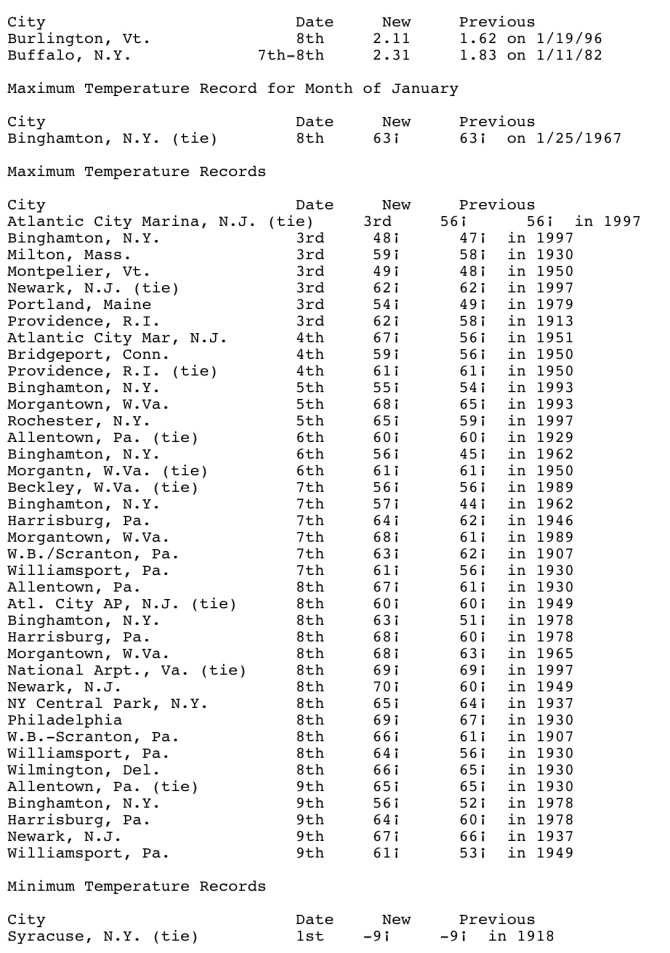Forget Bermuda! Try Binghamton, N.Y., which hit a balmy 63-degree temperature in January
By Blaine Friedlander
January temperatures for the Northeast region of the United States averaged 7.7 degrees Fahrenheit warmer than normal, making it the 10th warmest January in the last 104 years of record-keeping, according to Keith Eggleston, a senior climatologist at the Northeast Regional Climate Center at Cornell University.
During the month, 39 high-temperature records were broken or tied throughout the region. One particularly balmy spot, Binghamton, N.Y., tied its high-temperature record for January, set in 1967, with 63 degrees on Jan. 8.
"It has really been a consistent period of warm weather in January," says Eggleston. "This year has been a prolonged break from the usual winter weather pattern. We never really had a prolonged cold period to start out. It has been warm all the way through."
This winter's warm temperature pattern has been consistent with several other El Ni–o winters. However, Eggleston notes that a warmer January is not necessarily related to El Ni–o.
Normally, the area-weighted average temperature for the Northeast is 22.1 degrees Fahrenheit, but the January average this year was 29.8 degrees, which could make it the ninth-warmest January since 1895. Eggleston says that when all the smaller stations have reported, January 1998 could move ahead of the average of 29.9 degrees in January 1953. The warmest January on record was in 1932, when the area-weighted average temperature reached 34.9 degrees.
This January, Maine reported a monthly average temperature 3.8 degrees Fahrenheit warmer than the normal of 13.7 degrees. Each of the region's 11 other states had monthly departures that ranged between 5.5 and 10.5 degrees warmer than normal. New Jersey reported its third-warmest January on record, with a statewide monthly average that was 10.5 degrees warmer than the January normal temperature of 29.3 degrees. It was the fifth-warmest January in Delaware, up by 9.7 degrees from the normal 32.5-degree temperature.
Several weather stations established daily temperature records between Jan. 3 and Jan. 9. On the 8th, Newark, N.J., climbed to a high of 70 degrees. Temperature departures for that week ranged from around 9 degrees warmer than normal in northern Maine to more than 27 degrees warmer than normal in parts of Pennsylvania.
"Normally, during the last part of January and the first part of February we get the coldest temperatures of winter," says Eggleston. Temperatures are now on the upswing, he notes.
During January, excessive amounts of precipitation were reported across the 12-state region. Unfortunately, some of the precipitation fell in the form of freezing rain for an extended period of time between Jan. 4 and Jan. 9 from northern New York to central Maine. This created one of the most catastrophic ice storms ever in the region. Flooding was also a problem, as record water flows were reported Jan. 9 along the Hudson River near Newcomb, N.Y., where the National Weather Service recorded 11,000 cubic feet per second, breaking the old January record of 7,400 cubic feet per second, set in 1949.
Precipitation totals for the month exceeded 5 inches in Maine, New Hampshire, Vermont, Rhode Island, New York and Delaware. It was the third-wettest January on record in New York, which reported 198 percent of normal (2.58 inches), or 5.10 inches, this month. Vermont saw its fourth-wettest January, with 225 percent of its normal 2.49 inches, or 5.59 inches. For the entire Northeast, it was the fifth-wettest January since comparable records began in 1895. The regional area-weighted average of 4.78 inches was 167 percent of normal January precipitation.
New Weather Records
24-Hour Precipitation Records for Month of January (inches)
Media Contact
Get Cornell news delivered right to your inbox.
Subscribe